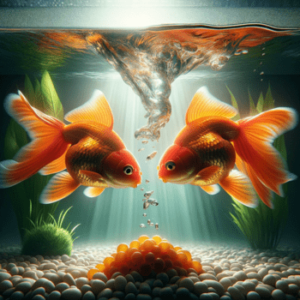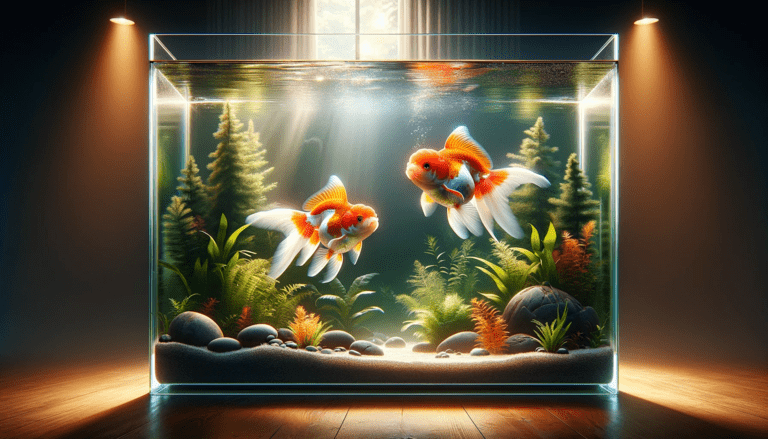Goldfish, with their vibrant colors and serene swimming patterns, have long been cherished as household pets. Contrary to popular belief, these creatures are not just short-lived novelties. The lifespan of a goldfish is a fascinating subject, shrouded in many misconceptions and little-known facts. In this comprehensive exploration, we dive into what determines how long these beloved aquatic pets live. From their historical origins to the intricacies of their care, understanding the lifespan of goldfish offers insight into how we can provide better environments for these popular pets.
Understanding Goldfish Lifespan
Historical Perspective on Goldfish Lifespans
The journey of the goldfish began over a thousand years ago. Originating in East Asia, these fish have been a symbol of luck and prosperity in cultures around the world. Historically, goldfish were treasured by the elite and were selectively bred for their aesthetic qualities, leading to the wide variety of breeds we see today. This long history reveals that goldfish are not inherently short-lived; in fact, their ancestors, the wild carp, are known for their lengthy lifespans.
Factors Affecting Lifespan
The lifespan of goldfish in captivity varies significantly, influenced by several key factors:
- Environment: The size and quality of their habitat play a crucial role. Goldfish thrive in spacious tanks with clean, well-oxygenated water.
- Diet: Proper nutrition is essential for their longevity. A balanced diet boosts their immune system and overall health.
- Genetics: The breed of goldfish can affect their lifespan. Common goldfish tend to live longer than fancy varieties.
- Care and Maintenance: Regular tank cleaning, water quality checks, and disease prevention are crucial.
- Stress Factors: Goldfish are sensitive to stress from factors like improper tank mates, overfeeding, or rapid environmental changes.
By considering these aspects, we start to understand that the lifespan of a goldfish is not just a matter of chance but a result of careful and informed caretaking.
Lifespan Variability in Different Conditions
Lifespan in Bowls vs Tanks vs Ponds
The living environment of a goldfish significantly impacts its lifespan. In small bowls, goldfish rarely thrive and their life expectancy is dramatically reduced, often to just a few months. This is due to limited space, poor water quality, and lack of filtration. In contrast, goldfish in larger tanks have a better chance of reaching their full potential, living anywhere from 10 to 20 years with proper care. Ponds, which closely mimic their natural habitat, offer the best conditions for longevity. In a well-maintained pond, goldfish can surpass 20 years, with some living up to 40 years.
Impact of Care and Environment on Lifespan
Consistent, high-quality care and a suitable environment are key to extending a goldfish’s life. Factors such as regular water changes, appropriate feeding, disease prevention, and stress reduction are crucial. A stable, clean, and spacious environment, coupled with attentive care, can dramatically increase their lifespan, showcasing the remarkable resilience and longevity of these fish when properly cared for.
Housing Condition for Goldfish |
Estimated Lifespan |
| Bowl for Goldfish | Less than 2 months |
| Smaller Aquarium, Neglected | 2 to 6 months |
| Smaller Aquarium, Properly Cared For | 6 months to 2 years |
| Medium-Sized Tank, Neglected | 6 months to 2 years |
| Medium-Sized Tank, Well-Kept | 2 to 5 years |
| Larger Aquarium, Neglected | 2 to 5 years |
| Larger Aquarium, Inadequate Maintenance | 4 to 8 years |
| Larger Aquarium, Well-Maintained | 6 to 10 years |
| Larger Aquarium, Exceptional Care | Over 10 years |
Goldfish Types and Their Lifespans
Lifespan Differences between Common, Comet, Shubunkin, and Fancy Goldfish
Different types of goldfish have varying lifespans due to genetic and physical differences. Common goldfish, including Comet and Shubunkin varieties, are known for their longer lifespans, often living well over 10 years in optimal conditions. These types, with their more streamlined bodies, are generally hardier and less prone to health issues.
Comparing the Lifespans of Different Goldfish Types
Fancy goldfish, with their distinct physical traits like bulbous bodies and elaborate fins, tend to have a shorter lifespan, usually around 7 to 12 years. This is attributed to their selective breeding which, while visually appealing, often makes them more susceptible to health issues and environmental stress. Understanding these differences is crucial for prospective goldfish owners to set realistic expectations and provide the best care suited to their chosen type.
Goldfish Care: Maximizing Lifespan
Importance of a Large Tank
A spacious tank is fundamental for a goldfish’s health and longevity. Goldfish need ample room to swim and grow, as cramped conditions can stunt their growth and lead to health problems. A minimum of 20 gallons for the first goldfish and an additional 10 gallons for each subsequent one is recommended to provide adequate space and ensure a longer, healthier life.
Proper Filtration and Water Cycling
Effective filtration systems are crucial for maintaining water quality, removing waste, and keeping ammonia and nitrite levels in check. A well-cycled tank, where beneficial bacteria have established themselves, helps in breaking down harmful toxins, creating a stable environment essential for goldfish health.
Regular Water Quality Checks
Consistent monitoring of water parameters, including pH, ammonia, nitrite, and nitrate levels, is vital. Regular water testing and changes, typically every two weeks, help maintain a clean and healthy tank, significantly impacting the goldfish’s lifespan.
Diet and Nutrition for Longevity
Importance of a Balanced Diet
A well-balanced diet is key to a goldfish’s health. This includes a mix of high-quality pellets or flakes, supplemented with fresh vegetables, fruits, and occasional protein sources like brine shrimp or daphnia. This variety ensures that goldfish receive all the necessary nutrients for a strong immune system and overall well-being.
Common Feeding Mistakes and Their Impact
Overfeeding is a common mistake that can lead to obesity and water quality issues, as uneaten food decomposes and pollutes the tank. Feeding goldfish the right amount and type of food, and avoiding frequent or excessive feeding, helps prevent digestive issues and maintains optimal water conditions, contributing to a longer lifespan.

Health Challenges and Lifespan
Common Health Issues in Goldfish
Goldfish are susceptible to various health issues, including swim bladder disease, fin rot, and ich (white spot disease). Poor water quality and inadequate diet are common culprits behind these conditions. Recognizing the signs of these illnesses early, such as changes in swimming patterns, discolored fins, or white spots on the body, is crucial for timely intervention.
Preventative Care and Treatment
Regular tank maintenance, balanced nutrition, and stress reduction are key preventive measures. In case of illness, specific treatments like medicated food or water additives can be effective. Consulting with a veterinarian specializing in fish can provide guidance on appropriate treatments.
Genetics and Lifespan
Role of Genetics in Determining Lifespan
Genetics play a significant role in the lifespan of goldfish. Inherently, certain goldfish breeds have longer lifespans than others. Genetic predispositions can also influence susceptibility to certain diseases, impacting overall longevity.
Selecting Healthy Goldfish from Reputable Sources
Purchasing goldfish from reputable breeders or pet stores ensures a healthier genetic stock. These sources often provide fish that have been bred in optimal conditions and are less likely to have genetic disorders. It’s important to observe the goldfish’s activity levels, body condition, and signs of any health issues before making a purchase.
Lifespan of Goldfish in Different Environments
Comparison of Lifespan in Home Aquariums, Ponds, and Wild
Goldfish lifespans vary greatly depending on their environment. In home aquariums, with proper care, goldfish can live for 10 to 15 years. In outdoor ponds, where conditions more closely resemble their natural habitat, they can live for 20 years or more, benefiting from larger space and natural food sources. In the wild, goldfish lifespans can be extensive, with some species adapting and thriving in varied freshwater ecosystems.
Goldfish Lifespan Myths vs. Reality
Debunking Common Myths
A common myth is that goldfish have inherently short lifespans. Reality contradicts this, showing that with proper care, goldfish can live for decades. The misconception stems from widespread inadequate care, particularly in small bowls with poor water quality.
Realistic Expectations for Goldfish Lifespan
Realistically, a well-cared-for goldfish in a home aquarium or pond can live much longer than many expect, often exceeding 10 years. Understanding their needs and providing an appropriate environment are key to achieving this longevity.
Case Studies: Oldest Goldfish in Aquarium Settings
Case Study 1: “Swimmy” – The Decades-Old Aquarium Goldfish
“Swimmy,” a goldfish kept in a 40-gallon home aquarium, lived an astonishing 20 years. Swimmy’s owner, a dedicated aquarist, attributed this longevity to a strict regimen of tank maintenance, including weekly water changes and regular filter cleaning. The diet was varied, consisting of high-quality flakes, pellets, and fresh vegetables. Swimmy’s environment was enriched with aquatic plants and decorations, providing both stimulation and places to explore. This case study exemplifies how dedicated care in a home aquarium can significantly extend a goldfish’s life.
Case Study 2: A School’s Goldfish Exceeds Expectations
In a high school biology lab, a goldfish named “Bubbles” surpassed all expectations by living for 15 years in a 30-gallon tank. Bubbles was part of an educational program where students learned about aquatic life and ecosystem management. The tank was meticulously maintained, with students and teachers ensuring optimal water quality and a balanced diet. Bubbles received regular health checks and lived in a well-planted tank, which helped reduce stress and provide natural foraging opportunities. This case illustrates the potential for goldfish longevity in educational settings where proper care and attention are prioritized.
Practical Tips for Extending Goldfish Lifespan
Day-to-Day Care Tips
- Regular Feeding: Feed your goldfish 2-3 times a day, offering only as much as they can consume in a few minutes to prevent overfeeding.
- Daily Observations: Check for abnormal behavior or signs of illness. Regular observation helps in early detection of potential health issues.
- Tank Maintenance: Perform daily checks on the tank’s filtration system and water temperature to ensure a stable environment.
Long-Term Health Maintenance Strategies
- Routine Water Changes: Change 20-30% of the tank water weekly to maintain water quality.
- Balanced Diet: Include a variety of foods in their diet, supplementing dry food with fresh vegetables and occasional protein treats.
- Regular Health Check-ups: Schedule yearly check-ups with a vet specializing in fish to catch any health issues early.
Conclusion
Caring for goldfish requires more than just feeding and cleaning; it involves understanding their needs and providing a nurturing environment. By implementing these practical day-to-day and long-term strategies, you can significantly extend the lifespan of your goldfish. Responsible care and attention are key to ensuring your goldfish not only survives but thrives for many years, allowing you to enjoy the beauty and tranquility these creatures bring to your home.



